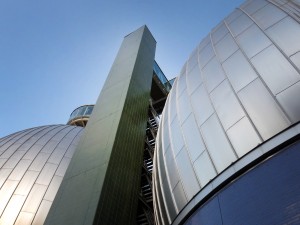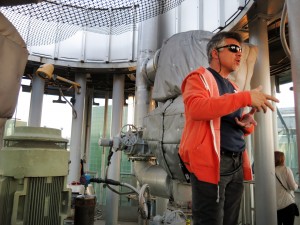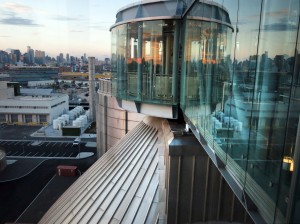Wicked Waters
Posted by on October 26, 2013Living in a part of the world where waste is (for the most part) carried away from our immediate living spaces by municipal services, it’s easy to maintain an out of sight, out of mind attitude about our unwanteds and castoffs. In an attempt to kindle a relationship with such materials, I’ve spent much time over the past couple of years trying to track object byproducts—such as food packaging, that result from the goods I consume, but little time investigating the pathways, destination, and management of the bodily wastes and greywater that disappear down my kitchen and bathroom drains.
I recently took a tour with my studio class of New York City’s Lower East Side. The guide described the area surrounding the famous Five Points as a cesspool before basic plumbing was introduced. Garbage and excrement was tossed from the windows of early tenement houses into the street gutters below, where it remained until rainwater carried it into lower lying land and the surrounding waterways. Cholera, dysentery, hepatitis, and typhoid were rampant. In an attempt to mitigate the disease, odor, rodent infestation, mosquito swarms and other problems associated with living amongst coliform bacteria (found in fecal matter) and other harmful pathogenic organisms, initial steps were taken to pipe waste material through hollowed out logs into receiving waters.
Though the topic wasn’t the main focus of the tour, the problem of maintaining sanitation in densely populated urban environments has been heavy on my mind ever since. As I move through this city on my way to and from school and work, and as my bus is regularly detoured around sewage construction, I wonder more and more about the vast infrastructure and systems in place to bring water into our homes for drinking, cooking, and hygienic practices, and also about the separate systems that take our soiled water “away.” So, when a fellow student hipped me to an Open House New York event, I jumped at the chance to visit The Newton Creek Waste Water Treatment Plant in Greenpoint—the largest treatment facility in the city.
Since the plant was renovated, the site has become a destination for curious NYC residents and tourists who are drawn to the strangely beautiful glinting vessels jutting out of the shore of Newton Creek. The visit is divided into two parts. First, we were treated to an in-depth information session and slide show about the history of New York City’s wastewater management and the current operating systems and facilities. I learned that before treatment programs were established, the waters surrounding New York City were so filthy, that ship captains used to dock in the toxic harbors and rivers just to kill the barnacles and shipworms that clung to the hulls of their vessels. In 1887, when human feces floating in the surf at Coney Island threatened commerce, several small sewage plants were erected, making Brooklyn the first city in the United States to treat its water. But it wasn’t until the federal government passed the Clean Water Act in 1972 restricting the release of toxic substances into water, that living organisms started to return to the dead zone that enveloped the city. Today, 7,400 miles of sewer pipe, 135,000 sewer catch basins, 95 wastewater pumping stations, 14 treatment plants, 4 sewer overflow facilities, and 3 sludge vessels all humbly do a job that New York City can’t live without. There are also 74 checkpoints located around the 5 boroughs where analysts test turbidity (a measurement of suspended particles) and oxygen levels of the water in the canals, rivers, and bays that surround us.
Wastewater that flows into the treatment facility undergoes five processes before it is allowed to flow back out into the waterways.
Preliminary treatment is essentially a screening process to remove large floatables (trash and other debris) from the influent water, which pose a threat to pipes and facility equipment.
Primary treatment happens in the first sedimentation tanks. Here, the water flow is slowed so that heavy solids can sink to the bottom and lighter solids like grease and small bits of plastic float to the top where they are skimmed off.
Secondary treatment is also known as the activated sludge process. “Seed” sludge collected at the plant is added to the wastewater to help break down harmful pathogens. Air is pumped into the tanks to stimulate the growth of oxygen-using bacteria. These organisms feast on remaining water pollutants and then sink to the bottom of the tanks once they are full. Some of this settled secondary sludge is re-circulated back into the activated sludge process and the rest is removed from the tank for further processing.
Even after primary and secondary treatments remove 85% to 95% of pollutants from the wastewater, disease-causing organisms may persist. So before the effluent can be released back into the environment, it must be treated with sodium hypochlorite, the same chemical found in common household bleach. This is the disinfection phase. Wastewater spends a minimum of 15-20 minutes in chlorine-contact tanks before it is flushed back into waterways.
The final processing stage is the sludge treatment. The sludge collected from the sedimentation tanks during the secondary treatment is digested for stabilization and is then dewatered for easier handling. The resulting material, known as biosolids, is applied to land to improve vegetation or processed further as compost or fertilizer.
The second part of the plant was the tour of the plant’s digester eggs. Eight stainless steel-clad digester eggs rise out of a highpoint on the plant property. We took turns riding the elevator up to the observation decks. There our guide described the biomimicry of the oxygen-free tanks that act much like our own stomachs. Inside anaerobic bacteria feed on organic material in the sludge. We were able to peer down into the belly of the tank to see the churning bubbling contents.
The view from atop the eggs was lovely at sunset.
An important takeaway from my visit to the plant is a new appreciation of the combined sewer overflow (CSO) phenomenon. During a heavy rain or snowfall, stormwater entering the system can raise wastewater levels volumes that exceed the amount of influent water our sewers and treatment plants were designed to handle. To protect infrastructure and facilities and to prevent flooding in the city streets, the excess water is discharged into the open waters. CSOs are a concern because they raise the bacteria count in our waterways. These bacteria consume and dissolve the oxygen that marine life needs to survive and as I’ve discussed, pose a threat to our health. CSOs also wash other pollutants such as litter, and motor oil into the surrounding rivers and bays.
So what does this mean to NYC residents? There are some very simple things that each of us can do to help reduce our personal contribution to the surge water in the sewers during a storm, like being conscious of how often we flush the toilet—“if it’s yellow, let it mellow.” as they say. We can try to plan showering, dishwashing, and laundering at times when the water is not falling from the sky.
Furthermore, green infrastructure implemented by the city and by property owners can also help to reduce CSOs. Rooftop detention (blue roofs), rainwater barrels, landscaping in place of concrete, and streetside swales are just a few examples.


